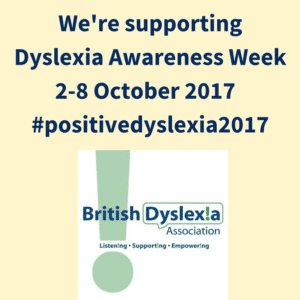Today marks the start of Dyslexia Awareness Week (2nd – 6th of October) in association with the British Dyslexia Association (BDA)! At iansyst, we hope this week will encourage you to share your thoughts and experiences, whether you have the condition yourself or if you are a parent of a child with dyslexia.

Dyslexia can affect a person’s reading, writing and spelling but it can also affect other areas such as working memory, sequencing, orientation, time management and much more. The severity levels differ from each individual, so not everyone with the condition will experience the same symptoms, so it’s important to understand what to look out for, especially if you are a teacher or parent. Since dyslexia affects an estimated one in ten people in the UK, being able to identify the condition early can help those who are affected, so each individual can receive the relevant support and tools to increase their confidence for their time at school and throughout the later stages of their life.
Early Signs of Dyslexia
Dyslexia becomes more apparent in children once they reach school, however it can be possible to detect signs in preschool children. Symptoms can include:
- Problems with speech, such as not being able to pronounce longer words and getting words mixed up
- Unable to express themselves, either having difficulty articulating sentences or remembering words.
- They may finding rhyming difficult and have little interest in the alphabet
You may also detect a delay in their speech development for their age group, however it’s important to point out this this can also be linked with problems other than dyslexia.
Signs of Dyslexia in School Children
When children reach school age, this is when symptoms become more present, as they are encourage to read, write and spell on a daily basis. It’s important to look out for the following:
- Poor and inconsistent spelling, such as adding and omitting letters
- Difficulty reading aloud and regularly making errors
- Poor handwriting
- Struggling to carry out directions
- Having trouble learning sequences such as the months of the year
- Poor phonological awareness
- Slow writing speed
Dyslexia doesn’t have a cure but there are lots of tools out there to overcome any difficulties faced by the condition. At iansyst, we have dedicated assistive technology to help you or your child fulfil their potential and instil confidence. We offer a range of products, such as Typing Tutors, text-to-speech and note taking software and equipment that relieves visual stress.
For more information on our full range of products, please take a look at our website or if you have any questions, ring us on 01223 420 101.

That was a very well presented introduction to dyslexia. It clearly explained many of the issues relating to dyslexia but took the fear out of accepting a diagnosis. I will be forwarding this to other parents and teachers.
Pingback: How Can Teachers Support Dyslexic Students? | Dyslexic.com
That was really helpful information about dyslexia. It helps to understand the symptoms as well as signs of dyslexia in children. Other casual symptoms of dyslexia include speech impairments, headache, reading ability delayed and other such related disorders.